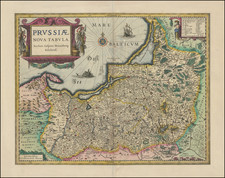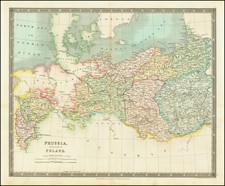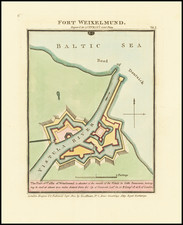Detailed map of Silesia, published in Cologne by Quad.
The map is centered on Breslau (Wroclaw).
The map is based upon an earlier map by Martin Helweg (1516 - 1574) a German cartographer of and from Silesia and pedagogue. Helwig studied at the University of Wittenberg, where as a student of Martin Luther and Philip Melanchthon he earned the academic degree of Magister. In 1552, he became Rector of St. Maria Magdalena School in Breslau (now Wrocław, in Poland). Equally proficient in mathematics and geography as well as classical languages, he produced the first woodcut map of Silesia made on the basis of surveys and data collected from local inhabitants, which he published in 1561 under the title "Silesiae Typus", and dedicated to Nicolaus II. Rehdiger, a wealthy Silesian merchant, banker, philanthropist, governor and patron of the principality of Breslau (Wrocław) who sponsored the map. Martin Helwig's map went on to receive acclaim in a public writing by Caspar Peucer, an eminent German scholar at the University of Wittenberg, and was later republished in several versions of Abraham Ortelius's Theatrum Orbis Terrarum.
Matthias Quad (1557-1613), a map publisher based in Cologne, was trained in the Netherlands by Johannes van Doetecum, who also worked with the De Jodes. Quad used many De Jode maps as a base to which he added additional information and decorations. Quad was best known for his atlases, which were part of the first boom in atlases best characterized by Abraham Ortelius’ Theatrum Orbis Terrarum. In 1592, Quad released an atlas of Europe that had 38 maps. He expanded it in 1594 to 50 maps. In 1600, he expanded the collection of maps further still, this time to 82 maps, and called the atlas, Geographisch Handtbuch. All three were small in size, allowing them to compete as cheaper alternatives to the larger atlases of Ortelius, Mercator, and the De Jodes. Quad released one other atlas, in 1608, with 86 maps, the Fascilus Geographicus.










![[ Holy Roman Empire ] S. Imperium Romano-Germanicum oder Teutschlenad mit Seinen Angrantzenden Konigreichen und Provincien,...](https://storage.googleapis.com/raremaps/img/small/98433.jpg)
![(World War II - Jewish Resistance in Poland) ספר מלחמות הגיטאת [Book of the Ghetto Wars]](https://storage.googleapis.com/raremaps/img/small/81013.jpg)


![[ Poland / Lithuania / Kaliningrad ] Das Konigreich Preussenmit den freien Stadten Danzig u Thorn](https://storage.googleapis.com/raremaps/img/small/102639.jpg)